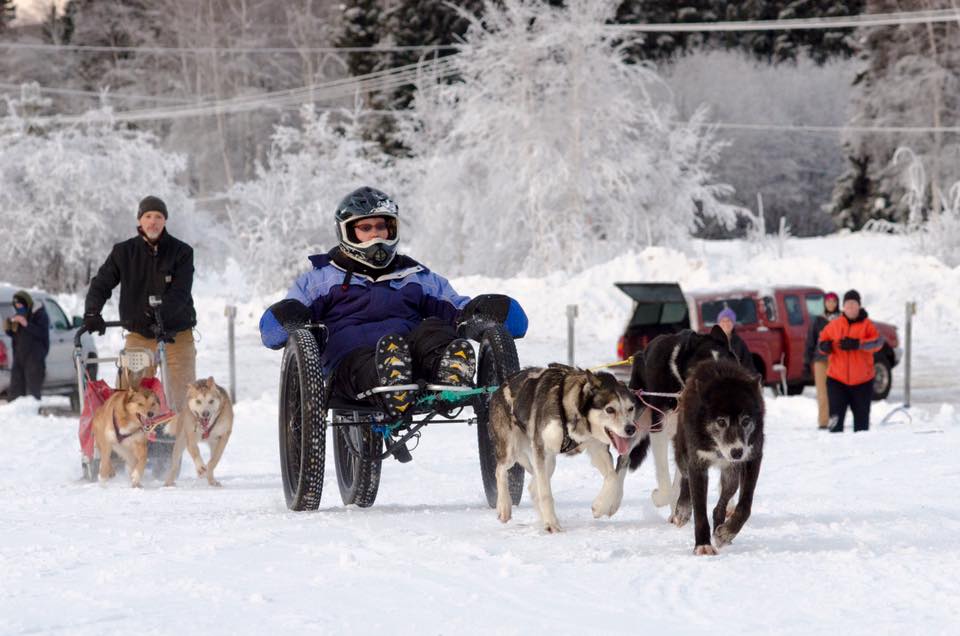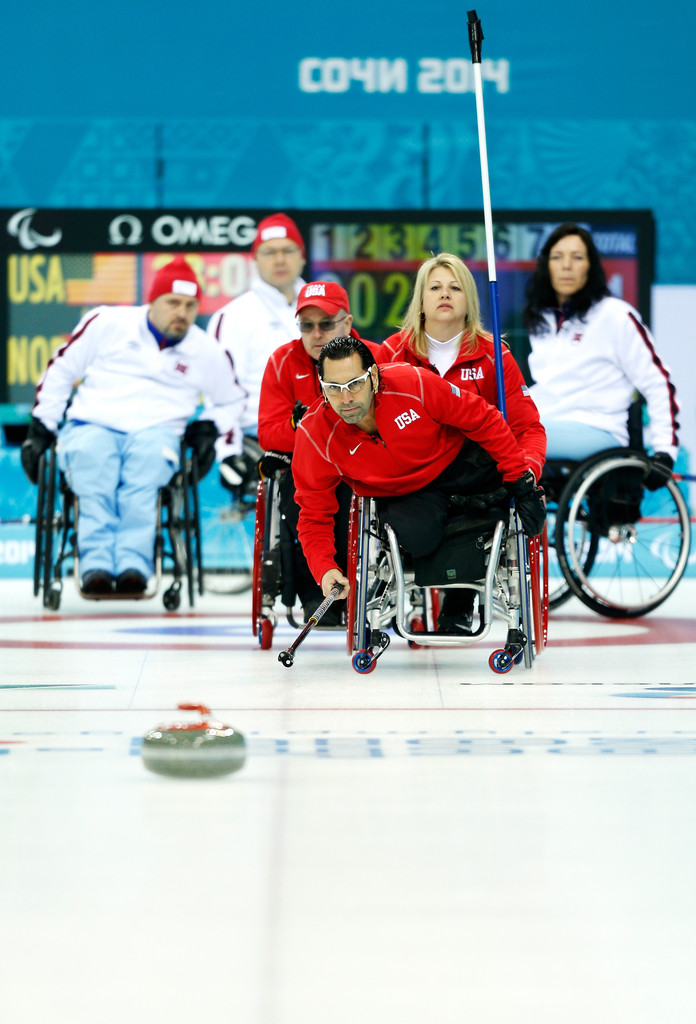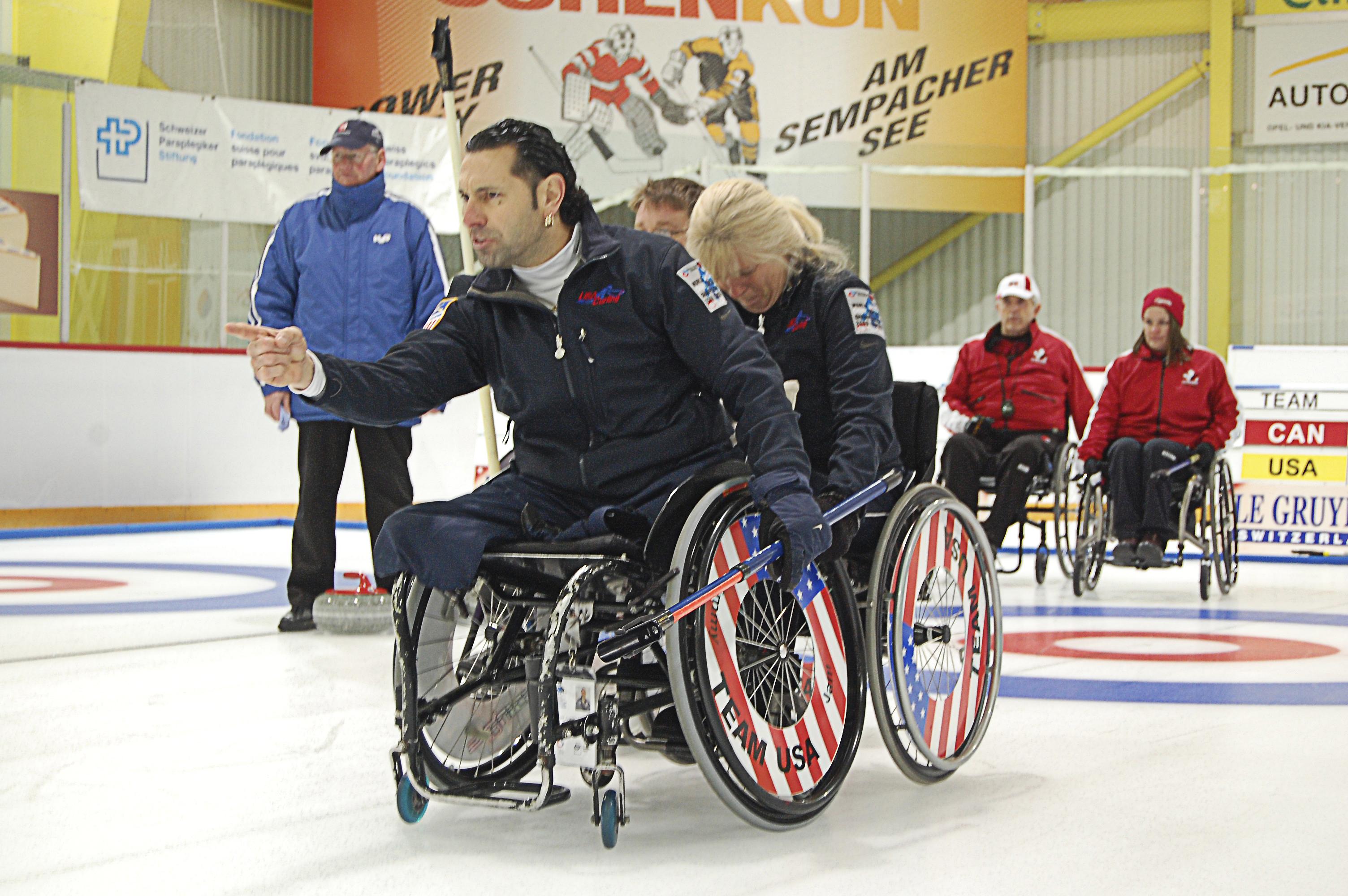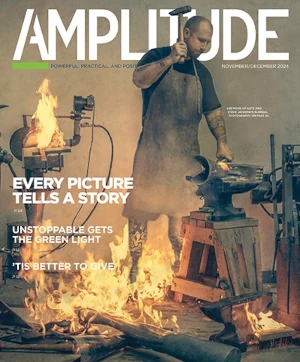By Rene Agredano
Decades ago, it would have been almost impossible for an amputee to ski or play hockey. Not anymore. Today, nearly any winter sport can be adapted for amputees. What’s even more exciting is that many are fully inclusive and played on mixed-gender teams with people of different ages and abilities. Today’s adaptive winter sports offer a fun way to stay fit, meet people, and maybe even take your talents to a new level. Here’s how to get started.
FIND INSTRUCTION
Winter sports coaching is closer than you think. Dozens of nonprofit organizations across North America help amputees get outside through coaching and events, from festivals like The Hartford Ski Spectacular in Colorado to long-term classes and drop-in clinics. Start your search at the Disabled Sports USA (DSUSA) chapter directory, featuring approximately 200 adaptive sports programs with the equipment and knowledge to help you grow as an athlete.

Ski Spectacular, © Reed Hoffmann.
Hartford Ski Spectacular www.skispec.org

DSUSA www.disabledsportsusa.org/chapters/location-map
If we can see past preconceived limitations, then the possibilities are endless. —AMY PURDY, THREE-TIME PARALYMPIC MEDALIST.
DON’T LET COST BE AN OBSTACLE
Many organizations, such as the Challenged Athletes Foundation, the Who Says I Can’t Foundation, and the High Fives Foundation, can offset much, if not all, equipment and training costs. “We are proud to say that in our 30-plus years, we have never had to turn anyone away due to an inability to pay and have been able to grant at least partial (if not full) scholarships to all applicants requesting assistance,” says Whitney Thompson of Utah’s National Ability Center (NAC).

Challenged Athletes Foundation www.challengedathletes.org
Who Says I Can’t Foundation www.whosaysicant.org
High Fives Foundation www.highfivesfoundation.org
National Ability Center www.discovernac.org
LEAVE ASSUMPTIONS BEHIND
Whatever your interest, age, or sports experience, there’s probably an organization that can work with your unique needs. For example, when a mobility-impaired woman named Mary was determined to learn the art of training sled dogs, an organization called Noble Paws worked around her disability to make it happen. Led by Alaskan dog musher Steve Vick, Noble Paws helps people with disabilities gain independence and mobility through the sport of mushing. In the spirit of Alaskan ingenuity, Vick refurbished an existing hand-cranked off-road tricycle with extra-wide tires and sledding components to attach a small dog team. “We had to go with what already existed and adapt from there,” he says. Several years later, Mary still commandeers a team of sled dogs.
Noble Paws www.noblepaws.org

Don’t Hibernate. Participate.
Check out these videos of amputees who embrace the cold weather by getting active outdoors.
E.J. Poplawski (AK Amputee) First Day Skiing After Losing His Leg https://bit.ly/2P5bNwA
Amy Purdy: Love for Snowboarding Conquers All https://bit.ly/2Yj9JVV
Ottawa Teen With Prosthetic Foot Lives Out Hockey Dream https://bit.ly/2YaRB0v
Three Adaptive Winter Sports to Consider
SLED HOCKEY
The goal of sit-down hockey is the same as stand-up hockey: hit a puck past the goalie and into the net. The adaptive version is especially inclusive, as both able-bodied and disabled players compete while riding bucket sleds and using their arms to propel along the ice. “It’s a great workout, and a great way to be physically active for anyone,” explains John Reid, vice president of the Warrior Avs Hockey Team for veterans. “You are going the entire time, moving the puck with your right hand, then your left hand. It’s so fun and so challenging for anyone.”
USA Hockey is a helpful resource for locating sled hockey classes and clinics, like the Warrior Avs’ seasonal “Try Sled Hockey” events at their Greeley Ice Haus headquarters in Colorado. “The sport’s still growing,” Reid says, “but within each state there is probably a program going on. You wanna come play? We’ve got the equipment—come on out!”

Warrior Avs Hockey Team www.warrioravs.org
USA Hockey www.usahockey.com/sledcamps
SKIING, SNOWBOARDING, AND SNOWSHOEING
If whooshing down a snowy mountain on a beautiful wintry day is your dream, snow sports can make it happen. Instructors teach amputees of all ages and abilities to ski sitting or standing up using one or two skis, with or without prosthetic devices. Once the adaptations are made, a skier of any age can get on the slopes while enjoying a level playing field with others.
For instance, when Waylon Fleming wanted to learn to ski as a child, his dad turned to Achieve Tahoe, a chapter of DSUSA. As a lifelong skier himself, Fleming’s dad, Josh, could see the payoff of allowing his child to do the same. “It gives him an ease of movement that he can’t attain in other ways,” he says. Zipping down the mountain on a ski is one of the best ways for his son to experience a level of freedom that he wouldn’t otherwise get to enjoy. Today, Waylon Fleming is a sponsored athlete with big dreams. “I want to do Paralympics,” he says proudly. “I’m determined to get better.”

Achieve Tahoe www.achievetahoe.org
CURLING
Wheelchair curling is a relatively new adaptive winter sport that’s played almost the same as the able-bodied version. The game is played on ice with eight members of mixed-gender teams in wheelchairs who strategically slide 16 42-pound granite circular stones toward a bullseye target 138 feet away. Some players use telescopic delivery sticks to slide the stones; others use their arms. The closer each team gets to the center of the target, the higher the score. With myriad ways to earn points, no two games are ever alike, giving the game an exciting, unpredictable edge that participants enjoy.
“It’s such a strategic game, it keeps your mind going all the time,” says Paralympic curling athlete Jimmy Jam. He explains that the sport is friendly to any age, body type, or disability. “You can curl from age 2 to 102; that’s what’s beautiful about it. It’s a perfect winter sport.”
To locate a curling club near you, start at the DSUSA curling club directory. If you don’t see one near you, call your closest club and ask for referrals. You might just find one where you least expect it.
DSUSA Curling Club Directory https://bit.ly/2QI5vFB

If you’re not having fun, then what the hell are you doing? ALLISON JONES, EIGHT-TIME PARALYMPIC MEDALIST
GO BEYOND YOUR LIMITS IN WINTER

Get past the mental challenge of going outside during the dark, cold days of winter and you may discover a big payoff that lasts the whole year. “The self-esteem and improved mental health that comes with being involved in sport has a spider web effect,” says Marc DePerno, director of the Sitrin STARS (Success Through Adaptive Recreation and Sports) program in New York. DePerno’s program not only helps people keep active, but it is also instrumental in growing the careers of adaptive athletes like wheelchair curler Jimmy Jam. DePerno has seen the lasting effects of sports on hundreds of teammates and urges people to give sports a try. “Getting involved one time and then recognizing your potential, well, it just changes your life.”
Paralympian snowboarder Brittani Coury agrees. “Don’t mentally tell yourself you can’t do something. Because if you have enough determination you can do anything you want to do. I’m living, walking proof of that.”
Sitrin STARS www.sitrin.com/adaptivesports/reach-for-the-stars
Belief in oneself is incredibly infectious. It generates momentum. AIMEE MULLINS, PARALYMPIAN, MODEL, AND ACTRESS
WHERE TO TRY ADAPTIVE WINTER SPORTS IN THE UNITED STATES AND CANADA
CANADA
Adaptive Sports at Sun Peaks (ASSP), Kamloops, British Columbia www.adaptivesportsatsunpeaks.org
ASSP provides opportunities for people with disabilities to participate in adaptive snow sports programs alongside friends and family. Volunteer instructors teach lessons in drop-in or long-term classes.
MAINE
Maine Adaptive Sports & Recreation www.maineadaptive.org
Maine Adaptive offers alpine and Nordic skiing, snowboarding, and snowshoeing for individuals with disabilities and their families. Lessons are free, including ancillary costs like lift tickets and equipment.
UTAH
National Ability Center (NAC) www.discovernac.org
NAC helps individuals of all ages and abilities enjoy adaptive sports alongside friends and family. They offer instruction and multiday excursions throughout Utah in every season, regardless of one’s ability to pay.
NATIONWIDE
Disabled Sports USA (DSUSA) www.disabledsportsusa.org
DSUSA serves over 60,000 youth, wounded warriors, and adults through a nation-wide network of over 120 community-based chapters in more than 40 states. Each chapter offers instruction in dozens of seasonal sports. Search the chapter directory (www.disabledsportsusa.org/chapters/location-map) for a location near you
Brittani Coury
In Love With Snowboarding
When Brittani Coury chose amputation to end chronic ankle pain caused by a snowboarding accident, her loved ones were horrified, but she wasn’t. After enduring eight unsuccessful corrective surgeries that left her disabled and feeling like a caged tiger, Coury wanted to move on. “For me, amputating was like being released back into the wild, to do everything I wanted to do. And I got to re-fall in love with the sport I thought I couldn’t love anymore.”
Just 12 days after amputation, she was back on snow for a race. Over the next three years, Coury obtained a nursing degree and planned to become a life flight paramedic. But her life took a turn one day while she was watching the 2014 Sochi Winter Paralympics. She kept saying to herself, “I can do that!” and later proved it. In 2017, she earned a spot on Team USA then won a silver medal in the 2018 Winter Paralympics. Her life hasn’t been the same since.

Today at the age of 33, Coury is in her third season of competitive snowboarding. She races with able-bodied Team Utah and encourages anyone interested in winter outdoor activities to learn snowboarding, especially women. Her life’s work is to mentor the next generation of adaptive snowboard athletes, to give back to the sport that has enriched her life on many levels.
“I have so many moments of gratitude, of just being thankful to be out in the mountains with that feeling of freedom and appreciation,” she says. “I get to do something I did before. I feel like I’ve been given a second chance.”
Jimmy Jam
Chess on Ice
When James Joseph became a double amputee after a 1987 car accident, he only allowed himself about five minutes of self-pity. Then he embarked on a quest to get his athletic body moving again.
“I’m just that type of guy,” he explains. “I’ve got that attitude of wanting to go on. I just said to myself, ‘You can either sit here and feel sorry for yourself or just get on in life.’ The obvious choice was to go on and be happy, to turn something negative into a positive.”
Joseph tried other adaptive sports like wheelchair racing and basketball, but curling held the biggest attraction. He had a passing interest in the sport long before his accident, but the rules baffled him. Once he became part of a wheelchair curling team, everything fell into place. “When I threw my first stone, I just knew it was for me,” he says. Joseph especially appreciates the mental challenge and calls it “chess on ice.”

Today the New Hartford, New York, resident is a 12-time world champion and three-time Team USA curling Paralympian. Curling opened dozens of doors for the 57-year-old athlete known as “Jimmy Jam.” He has since toured the globe with Team USA and met three U.S. presidents along the way. “It’s just amazing how I went to so many places in my life,” he says. Curling has not only given him something to do in winter, but it’s also made him a legend in the sport.



